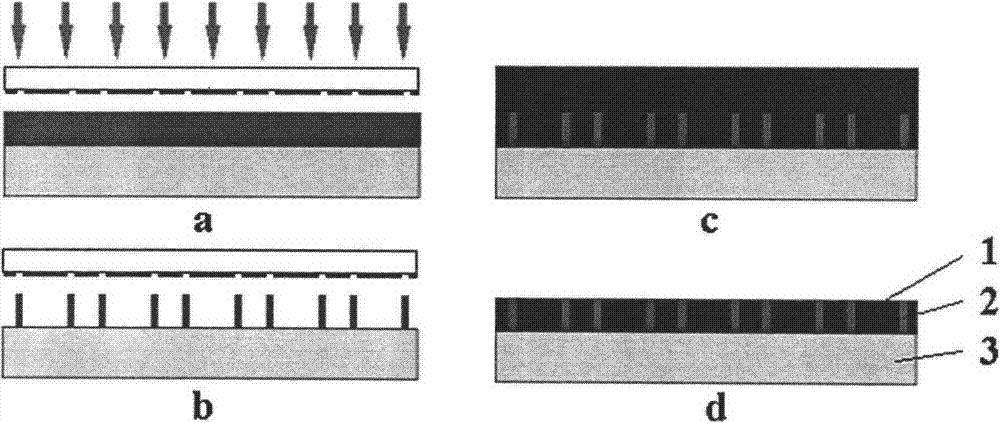A novel wave-absorbing function design with material and structure wave-absorbing functions being integrated
A wave function and integrated technology, applied to the parts of the instrument, shielding, instruments, etc., can solve the problem of limited structural size adjustment ability, and achieve the effects of wave absorption bandwidth and efficiency, optimized design, and wide range of structural changes
- Summary
- Abstract
- Description
- Claims
- Application Information
AI Technical Summary
Problems solved by technology
Method used
Image
Examples
Embodiment 1
[0019] Such as figure 1 and figure 2 Shown, embodiment 1 comprises the following steps:
[0020] The first step is to mix the SU-8 photoresist and the ferroferric oxide absorbing material at a weight ratio of 10:2, stir well and remove the air bubbles, and then spin-coat it on a glass sheet with a thickness of 1 mm. The spin-coating thickness is 500 Micron.
[0021] The second step is to place the spin-coated glass sheet in an oven for pre-baking to cure the photoresist, the pre-baking temperature is 90 degrees, and the time is 5 hours.
[0022] The third step is to expose the cured photoresist at 10mw / cm 2 Exposure to UV light for 200 seconds. The photoresist structure is a periodic hexagonal honeycomb structure.
[0023] The fourth step, intermediate baking and development, the intermediate drying condition is 90 degrees for one hour, and the developing condition is one hour.
[0024] The fifth step is to fill the metal wave-absorbing material in the hexagonal honeyco...
Embodiment 2
[0027] Such as figure 1 and figure 2 Shown, embodiment 2 comprises the following steps:
[0028] Step 1: Mix SU-8 photoresist and ferroferric oxide absorbing material at a weight ratio of 10:3, stir well and remove air bubbles, then spin-coat on a 1 mm thick glass sheet, the spin-coating thickness is 600 Microns.
[0029] The second step is to place the spin-coated glass sheet in an oven for pre-baking to cure the photoresist. The pre-baking temperature is 90 degrees for 6 hours.
[0030] The third step is to expose the cured photoresist at 10mw / cm 2 Exposure to UV light for 250 seconds. The photoresist structure is a periodic square structure.
[0031] The fourth step, intermediate drying and development, the intermediate drying condition is 90 degrees for 1.5 hours, and the developing condition is 1.2 hours.
[0032] The fifth step is to fill the carbon fiber absorbing material outside the square structure of the photoresist.
[0033] In this embodiment, a dual-mater...
Embodiment 3
[0035] Such as figure 1 and figure 2 Shown, embodiment 2 comprises the following steps:
[0036] Step 1: Mix SU-8 photoresist and ferroferric oxide absorbing material at a weight ratio of 10:3, stir well and remove air bubbles, then spin-coat on a 1 mm thick glass sheet, the spin-coating thickness is 600 Micron.
[0037] The second step is to place the spin-coated glass sheet in an oven for pre-baking to cure the photoresist. The pre-baking temperature is 90 degrees for 6 hours.
[0038] The third step is to expose the cured photoresist at 10mw / cm 2 Exposure to UV light for 250 seconds. The photoresist structure is a periodic cross structure.
[0039] The fourth step, intermediate drying and development, the intermediate drying condition is 90 degrees for 1.5 hours, and the developing condition is 1.2 hours.
[0040] The fifth step is to fill the carbon fiber absorbing material outside the square structure of the photoresist.
[0041] In this embodiment, a dual-materia...
PUM
 Login to View More
Login to View More Abstract
Description
Claims
Application Information
 Login to View More
Login to View More - R&D
- Intellectual Property
- Life Sciences
- Materials
- Tech Scout
- Unparalleled Data Quality
- Higher Quality Content
- 60% Fewer Hallucinations
Browse by: Latest US Patents, China's latest patents, Technical Efficacy Thesaurus, Application Domain, Technology Topic, Popular Technical Reports.
© 2025 PatSnap. All rights reserved.Legal|Privacy policy|Modern Slavery Act Transparency Statement|Sitemap|About US| Contact US: help@patsnap.com


